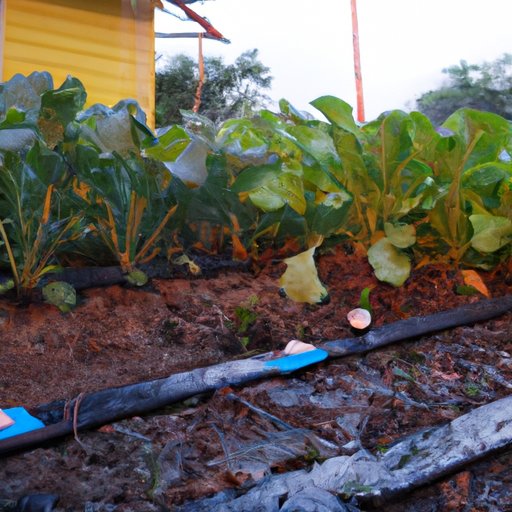Introduction
Growing your own vegetables can be a rewarding experience. Not only will you gain access to fresh produce, but it’s also an activity that can bring the whole family together. Starting a vegetable garden in your backyard is a great way to get started.
The first step in starting a vegetable garden is understanding the basics of gardening. This includes researching the local climate and soil type, designing the garden layout, purchasing the necessary supplies, preparing the soil, planting the seeds, and caring for the garden.
Research
Before beginning the process of creating a vegetable garden, it’s important to do some research on the local climate and soil type. Different vegetables require different growing conditions, so it’s important to understand what will work best in your area.
Climate
The climate in your area will determine which vegetables will grow best. Some vegetables are more tolerant of cold temperatures while others prefer warm weather. For example, according to the University of Wisconsin-Madison, “Tomatoes, peppers, and eggplants thrive in warmer climates, while lettuce, spinach, and other greens prefer cooler weather.” It’s important to research the plants you plan to grow and make sure they will thrive in your climate.
Soil Type
The type of soil in your area will also affect the success of your vegetable garden. Sandy soils drain quickly, while clay soils hold moisture longer. Loam soils, which contain a mix of sand, silt, and clay, are ideal for vegetable gardens as they provide good drainage and hold nutrients well. Additionally, soil pH should be tested before planting and amended accordingly. According to the National Gardening Association, “Most vegetables grow best in a slightly acidic soil with a pH of 6.0 to 6.8.”
Design
Once the research has been done, it’s time to start planning the design of the vegetable garden. The size and shape of the garden will depend on the amount of space available. A small garden can be created in just a few square feet, while larger gardens may require more space. Additionally, raised beds and container gardens are great options for those who have limited space.
Purchase
Now that the design of the garden is complete, it’s time to purchase the necessary supplies. Seeds, soil, tools, and other materials will be needed to create the garden. It’s important to read the instructions on each seed packet carefully to ensure the plants will grow in your area. Additionally, organic soil and fertilizer may be necessary to give the plants the nutrients they need to thrive.
Prepare Soil
Once the supplies have been purchased, it’s time to prepare the soil. This includes tilling the soil to loosen it up, adding fertilizer or compost to improve the nutrient content, and removing any weeds. Additionally, it’s important to check the drainage of the soil to ensure adequate water flow.
Planting
When it comes time to plant the seeds, it’s important to follow the instructions on the seed packets carefully. Different plants require different depths for planting and different spacing between plants. Additionally, it’s important to label each plant so you know what you planted and when.
Watering
Once the plants are in the ground, it’s important to keep them watered regularly. Depending on the climate and soil conditions, this could mean watering every day or every few days. Additionally, mulch or other organic matter can be used to help retain moisture in the soil.
Monitoring
It’s also important to monitor the garden for pests and diseases. If these problems arise, it’s important to take action immediately to prevent further damage. Additionally, it’s important to harvest vegetables as soon as they are ripe to ensure the best flavor and texture.
Conclusion
Starting a vegetable garden in your backyard can be a rewarding experience. By doing the necessary research, purchasing the right supplies, preparing the soil, planting the seeds, and taking care of the garden, you can enjoy the fruits of your labor all season long.
(Note: Is this article not meeting your expectations? Do you have knowledge or insights to share? Unlock new opportunities and expand your reach by joining our authors team. Click Registration to join us and share your expertise with our readers.)
